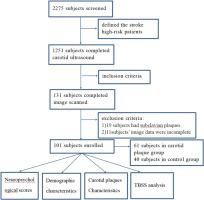当前位置:
X-MOL 学术
›
Clin. Neurol. Neurosurg.
›
论文详情
Our official English website, www.x-mol.net, welcomes your
feedback! (Note: you will need to create a separate account there.)
Micro-structural white matter abnormalities and cognitive impairment in Asymptomatic Carotid Plaque patients: a DTI study using TBSS analysis
Clinical Neurology and Neurosurgery ( IF 1.8 ) Pub Date : 2020-10-01 , DOI: 10.1016/j.clineuro.2020.106096 Lihui Liu 1 , Qing Huang 1 , Shuai Yang 2 , Yanbin Wen 1 , Wei He 1 , Hui Liu 2 , Li Meng 2 , Hong Jiang 3 , Jian Xia 1 , Weihua Liao 2 , Yunhai Liu 1
Clinical Neurology and Neurosurgery ( IF 1.8 ) Pub Date : 2020-10-01 , DOI: 10.1016/j.clineuro.2020.106096 Lihui Liu 1 , Qing Huang 1 , Shuai Yang 2 , Yanbin Wen 1 , Wei He 1 , Hui Liu 2 , Li Meng 2 , Hong Jiang 3 , Jian Xia 1 , Weihua Liao 2 , Yunhai Liu 1
Affiliation

|
BACKGROUND
It has been shown that symptomatic or severe carotid atherosclerosis is closely related to cognitive impairment and brain white matter damage. However, there is still a lack of effective and non-invasive imaging biomarkers to identify early high-risk cerebrovascular diseases. Therefore, the purpose of this study is to explore the integrity of brain white matter and cognitive impairment in patients with asymptomatic carotid plaques by using imaging technology. METHODS
All subjects were from a project of Stroke Risk Screening and Prevention and were defined as stroke high-risk patients (with three or more stroke risk factors). Tract-based spatial statistics (TBSS) based on diffusion tensor imaging (DTI) was used to analyze the whole brain white matter abnormalities in 61 patients with carotid artery plaque and in 40 healthy controls. At the same time, the general clinical data between the two groups were compared, such as age, gender, smoking, hypertension and cognitive function scores etc. Furthermore, the plaque group was divided into the have-hyperintensities group and the no-hyperintensities group to compare their microstructure of white matter injuries. RESULTS
The cognitive scores of plaque group were significantly lower than that of control group. We found that when plaque group and control group were compared, no white matter fiber tracts with difference was found in FA, MD, AD and RD. However, the decrease of FA and the increase of RD were found in some white matter regions (P < 0.05) when comparing the have-hyperintensities group and the no-hyperintensities group. These white matter regions included anterior thalamic radiation, corticospinal tract, cingulum (cingulate gyrus), forceps minor, inferior fronto-occipital fasciculus, superior longitudinal fasciculus, uncinate fasciculus. What's more, there were significant differences in blood pressure between the two groups. CONCLUSION
The cognitive function of patients with early high-risk cerebrovascular diseases (asymptomatic carotid plaques) has a downward trend. TBSS based on DTI can help to find out the actual damage of brain white matter in patients with early carotid plaque, and reflect the early pathological changes from the micro level.
中文翻译:

无症状颈动脉斑块患者的微结构白质异常和认知障碍:一项使用 TBSS 分析的 DTI 研究
背景研究表明,有症状或严重的颈动脉粥样硬化与认知障碍和脑白质损伤密切相关。然而,目前仍缺乏有效的非侵入性成像生物标志物来识别早期高危脑血管疾病。因此,本研究的目的是通过成像技术探讨无症状颈动脉斑块患者脑白质完整性和认知障碍。方法所有受试者均来自脑卒中风险筛查和预防项目,定义为脑卒中高危患者(具有三个或三个以上脑卒中危险因素)。使用基于扩散张量成像 (DTI) 的基于束的空间统计 (TBSS) 来分析 61 名颈动脉斑块患者和 40 名健康对照者的全脑白质异常。同时比较两组患者的一般临床资料,如年龄、性别、吸烟、高血压、认知功能评分等。进一步将斑块组分为有高信号组和无高信号组比较他们的白质损伤的微观结构。结果斑块组认知评分明显低于对照组。我们发现斑块组与对照组相比,FA、MD、AD和RD均未发现有差异的白质纤维束。然而,当比较有高信号组和无高信号组时,在一些白质区域发现FA减少和RD增加(P <0.05)。这些白质区域包括前丘脑放射、皮质脊髓束、扣带回(扣带回),小钳子,额枕下束,上纵束,钩状束。更重要的是,两组之间的血压存在显着差异。结论 早期高危脑血管病(无症状性颈动脉斑块)患者的认知功能有下降趋势。基于DTI的TBSS有助于发现早期颈动脉斑块患者脑白质的实际损伤情况,从微观层面反映早期的病理变化。结论 早期高危脑血管病(无症状性颈动脉斑块)患者的认知功能有下降趋势。基于DTI的TBSS有助于发现早期颈动脉斑块患者脑白质的实际损伤情况,从微观层面反映早期的病理变化。结论 早期高危脑血管病(无症状性颈动脉斑块)患者的认知功能有下降趋势。基于DTI的TBSS有助于发现早期颈动脉斑块患者脑白质的实际损伤情况,从微观层面反映早期的病理变化。
更新日期:2020-10-01
中文翻译:

无症状颈动脉斑块患者的微结构白质异常和认知障碍:一项使用 TBSS 分析的 DTI 研究
背景研究表明,有症状或严重的颈动脉粥样硬化与认知障碍和脑白质损伤密切相关。然而,目前仍缺乏有效的非侵入性成像生物标志物来识别早期高危脑血管疾病。因此,本研究的目的是通过成像技术探讨无症状颈动脉斑块患者脑白质完整性和认知障碍。方法所有受试者均来自脑卒中风险筛查和预防项目,定义为脑卒中高危患者(具有三个或三个以上脑卒中危险因素)。使用基于扩散张量成像 (DTI) 的基于束的空间统计 (TBSS) 来分析 61 名颈动脉斑块患者和 40 名健康对照者的全脑白质异常。同时比较两组患者的一般临床资料,如年龄、性别、吸烟、高血压、认知功能评分等。进一步将斑块组分为有高信号组和无高信号组比较他们的白质损伤的微观结构。结果斑块组认知评分明显低于对照组。我们发现斑块组与对照组相比,FA、MD、AD和RD均未发现有差异的白质纤维束。然而,当比较有高信号组和无高信号组时,在一些白质区域发现FA减少和RD增加(P <0.05)。这些白质区域包括前丘脑放射、皮质脊髓束、扣带回(扣带回),小钳子,额枕下束,上纵束,钩状束。更重要的是,两组之间的血压存在显着差异。结论 早期高危脑血管病(无症状性颈动脉斑块)患者的认知功能有下降趋势。基于DTI的TBSS有助于发现早期颈动脉斑块患者脑白质的实际损伤情况,从微观层面反映早期的病理变化。结论 早期高危脑血管病(无症状性颈动脉斑块)患者的认知功能有下降趋势。基于DTI的TBSS有助于发现早期颈动脉斑块患者脑白质的实际损伤情况,从微观层面反映早期的病理变化。结论 早期高危脑血管病(无症状性颈动脉斑块)患者的认知功能有下降趋势。基于DTI的TBSS有助于发现早期颈动脉斑块患者脑白质的实际损伤情况,从微观层面反映早期的病理变化。











































 京公网安备 11010802027423号
京公网安备 11010802027423号